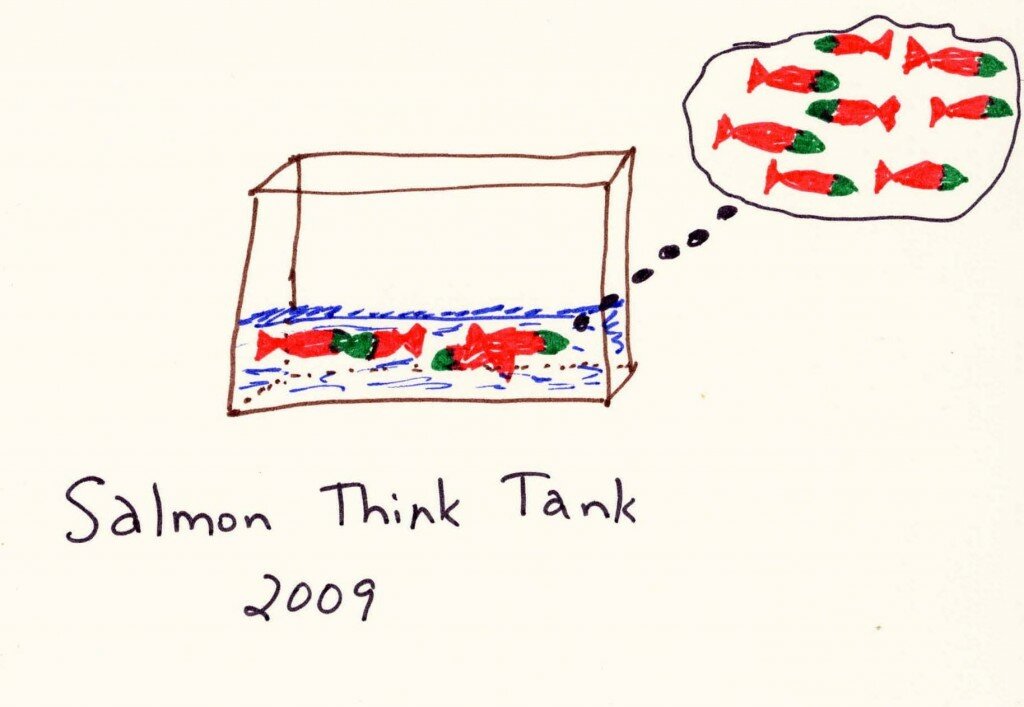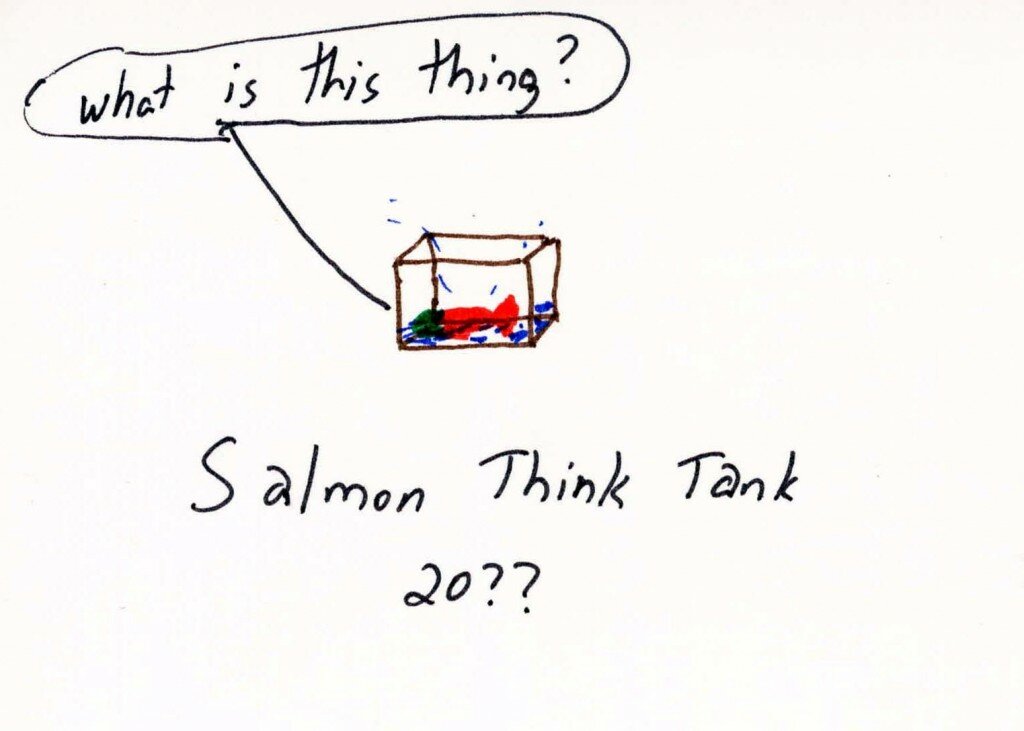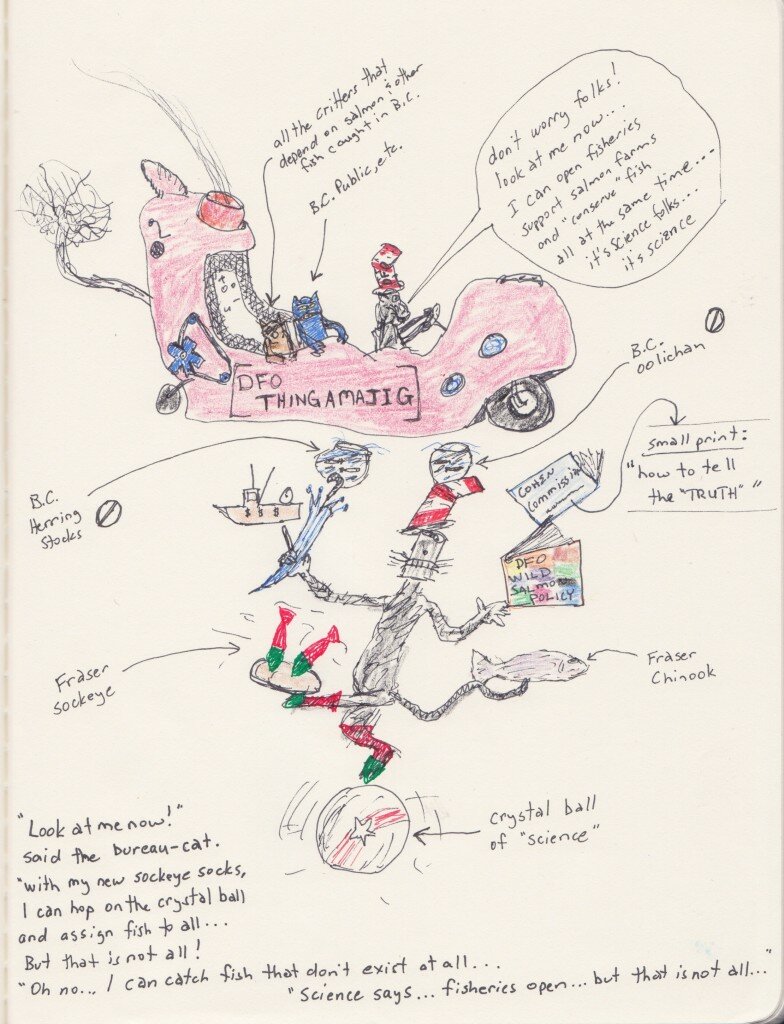Been quite a last little while for DFO’s brand of “science”. However, one might suggest it’s been that way for quite a long time…
The thing with “science” is that, in the sheer horror of scientists, it can be rather subjective.
“Science” prides itself, or at least the scientists that practice it, on this sheer imaginary principle of ‘objectivity’. Unfortunately, ‘objectivity’ is kind of like a Dr. Suess’ thingamajigger … even more so when ‘science’ is conducted to set human limits on either extracting things (generally for a cash return) or emitting things (also generally for a cash return).
You know extractive things like: fisheries, forestry, oil & gas production that in turn needs massive quantities of water, and the emitting ‘science’ surrounding human-induced climate change, or sewage treatment, or… or…
And even if science was ‘objective’ —- purely focused on the ‘objects’ of study with no influence of the scientist’s mind… or culture… or training… —- it still, the majority of the time, has to run flat on into politics, which in turn is largely dictated by the classic jobs vs. environment cliche.
Even the best ‘science’ of the day couldn’t help the North Atlantic Cod. Politics trumps science… at least for now. Until some scientists are asked to put humpty dumpty back together again…
Look no further than the recent climate change talks in South Africa… and our fine current Canadian ‘conservative’ approach to the issue… (deny, deny, deny… as mentioned multiple times on this blog… marketing is everything, everything is marketing).
The illustration above was motivated by a message sent around today on the issue of Herring stocks in the Salish Sea and DFO’s brand of “science” in ‘managing’ these stocks. (but don’t forget, herring are pretty key food species for many salmon, as well as all sorts of other critters).
“All of the [metastock] herring, leave the Salish Sea, in the winter”, is still officially the biological theory, that is the basis, of the 2012 DFO herring fishing plan (from DFO website):
Science Advisory Report 2010/064, Stock Assessment Report on Pacific Herring in British Columbia in 2010
“All herring spawning in Statistical Areas 14 to 19, 28 and 29 [both sides of the Salish Sea, from Campbell River, to Victoria] (excluding Section 293[Boundary Bay]), and part of 13 (Herring Sections 132 and 135[Cape Mudge], Deepwater Bay area south) are assumed to belong to the Strait of Georgia herring stock that migrates into the Strait in the late fall and leaves, after spawning, in March.”
So the large herring that will be landed and sold to the public at Steveston, today and tomorrow (see below) are the herring, that aren’t! (The 2012 DFO fishing plan, has set a separate quota, for the “migratory” roe herring fishery, to be taken in march, at Qualicum and at Denman Island). So the present Gulf islands “winter” herring fishery, is for herring, that are not officially, there, they, just, aren’t!
Please ask the fishermen at the sale! I am sure they will say the herring were taken in the Gulf Islands, within the “Salish Sea” statistical areas noted above, where the “official” DFO biology, says the “Strait of Georgia herring stock”, now, aren’t.
In the Dr. Seuss book “The Cat in the Hat”, the cat drives a “THINGAMAJIG”, which not only drives on land, but then, with the minimum of physical alteration, then flies and even goes underwater. Like the cobbled-together bio-data for the DFO 2012 herring fishing plan, the “THINGAMAJIG” can at will, defy all rational science, and go where it wants, because it actually is, of course, not based on science at all. The DFO 2012 herring fishing plan, is based only on politics (fish processing companies lobbying to an antiquated DFO “top-down” Ottawa-based management model). Put in a position where they have to defend this “entitlement to fish” despite the complete lack of study of the “resident” populations of herring, the only recourse for the DFO stock assessment biologists, is to, like the “Cat in the Hat”, carry on a complete aura of confidence, that all is based, on science. They must retain this complete confidence that so that no one (least of all a Judge from a court of Canadian law!) will challenge their bio-theories, which could lead to a court injunction, to close the fishery. But it simply is very very hard to challenge cheerful and confident, “Cats in Hats”, or DO stock assessment biologists, as they make fantasy, sound like reality.
The DFO has in fact, used up all of their fisheries biology currency, to provide the scientific justification, for a large annual quota for a roe herring fishery, on the “migratory” populations. But to achieve this large quota, the assumption had to be, that all local populations of herring, were actually one “metastock”, that could therefore be harvested in one location, with a very large quota. But the markets for roe herring, have now suddenly evaporated, while strong markets have now emerged, for the whole herring bodies, for human food, best caught in the winter before spawning.
So they have been caught with their “biological pants”, down; they have no reasoning left, to even say why the “resident” or “winter”, herring, are even in the Salish Sea, during the winter. The fish being caught now, simply, shouldn’t! In short, there is only “Dr. Seuss fantasy biology”, to explain the very existence, of the fish being sold now, at Steveston. In fact, the only “official” herring they can now be encountered in the Salish Sea, would in theory be the “young-of-the-year” (YOY) migratory, herring, who have not yet left, for the open sea:
Schweigert, J. F., Hay, D. E., Therriault, T. W., Thompson, M., and Haegele, C. W. 2009. Recruitment forecasting using indices of young-of-the-year Pacific herring (Clupea pallasi) abundance in the Strait of Georgia (BC). – ICES Journal of Marine Science, 66: 1681–1687:
“The timing of migration of YOY herring out of the Strait of Georgia to other feeding areas is not well understood. [remind you of the Cohen Commission and salmon “science”… remember: DATA GAP, the new clothing line for the Cohen Commission] The juvenile surveys conducted by Haegele (1997) provide the best evidence that many YOY and older herring (age 1) overwinter in the Strait and spend at least part of their second summer there. These same surveys, however, indicate that the abundance of older herring declined towards the end of their second summer.
Therefore, during the autumn period, most age-1 and older herring either migrated out of the Strait or to areas where they were not vulnerable to the sampling gear depending on their age. Additionally, Haegele et al. (2005) conducted some seine sampling in Johnstone Strait during 1998 and 1999 and found substantial quantities of YOY herring that may have been spawned in the Strait of Georgia. It appears that these fish had either migrated from the Strait of Georgia or were in the process of migrating from Johnstone Strait. Such migrations could bias survey results if their extent and timing varied markedly from year to year, but because the origin of these fish could not be determined, it is not possible to assess the potential bias. For example, YOY estimates of the 1999 and 2000 year classes differ markedly from the estimates at age 3 (Figure 3). These discrepancies could be a result of differential movements of fish in or out of the Strait as well as of variable environmental impacts on fish distribution and survival at the time of the surveys.”
“Based on tagging data and offshore survey analyses, most herring from the Strait of Georgia migrate to the west coast of Vancouver Island to feed offshore, and presumably mix with herring originating from the west coast or from other locations, such as Washington State, before returning as adults to spawn in the Strait of Georgia. Although we cannot be certain that all herring return, available tagging data (Hay et al., 2001) indicate that the rate of straying, when examined among the same large geographical units used for stock assessment, is quite low and should not substantially affect the comparison.”
—————
So I was wrong in my last posting, in saying that all “migratory” herring leave the Salish Sea, quickly; the “migratory” fish that hatch out, and spend time in the often declining eelgrass beds (the reality of habitat decline logically means less fishing, not more) and then may work their way out to either Juan De Fuca, or Johnstone Strait, over a period of a year. But they have just not been studied enough yet (as DFO notes, above); so the DFO does not really know, how long this takes them, or even which way [Juan De Fuca, or Johnstone Strait?] they go. But these tasty little “YOY” herring are VERY important to the feeding Coho (never recovered yet in Salish Sea since the collapse a decade go, I wondering why?) Chinook (read, key Orca food) ling cod, rock fish, porpoise, and many bird species.
Court room judges, who may now be called onto to decide if this fishery is in fact valid, under the laws and policies of Canada, need to take the time to carefully read the bio-jumble of the abundant DFO herring biology that is on line (see above), these papers actually admit many, data deficiencies. They also need to note, that the “metastock” theory used in B.C., is also strongly opposed by biologists in Washington State, who deny the existence of a “metastock”, and instead use “local stock” biological theories, to manage herring there (see http://www.nwfsc.noaa.gov/publications/techmemos/tm45/contents.htm). Even the lay-reader, will soon see that “modern science”, still knows very very little, about the Salish Sea herring, if opinions are so clearly and widely, divided.
In the end the only route to take at this time, if long term conservation of these fishes were indeed the policy of Canada (it definitely, is not, if the fish processing lobbyists, are left in control in the dysfunctional [from a public policy perspective] “top-down” Ottawa-based management system) is the super-pre-cautionary fishery as practiced by First Nations, probably learned the hard way about 1000 years ago, to just take just some of the herring eggs, a very few of the adults. And don’t scare the herring away, by hitting the canoe with your paddle!





